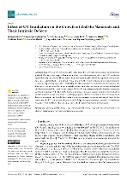Effect of UV Irradiation on the Growth of ZnO:Er Nanorods and Their Intrinsic Defects

Autor
Buryi, Maksym
Neykova, Neda
Landova, Lucie
Hajek, Frantisek
Babin, Vladimir
Decka, Katerina
Sharma, Rupendra Kumar
Pop-Georgievski, Ognen
Datum vydání
2023Publikováno v
ChemosensorsRočník / Číslo vydání
11 (3)ISBN / ISSN
ISSN: 2227-9040Metadata
Zobrazit celý záznamKolekce
Tato publikace má vydavatelskou verzi s DOI 10.3390/chemosensors11030156
Abstrakt
Nanorods of erbium-doped zinc oxide (ZnO:Er) were fabricated using a hydrothermal method. One batch was prepared with and another one without constant ultraviolet (UV) irradiation applied during the growth. The nanorods were free-standing (FS) as well as deposited onto a fused silica glass substrate (GS). The goal was to study the atomistic aspects influencing the charge transport of ZnO nanoparticles, especially considering the differences between the FS and GS samples. We focused on the excitons; the intrinsic defects, such as zinc interstitials, zinc vacancies, and related shallow donors; and the conduction electrons. UV irradiation was applied for the first time during the ZnO:Er nanorod growth. This led to almost total exciton and zinc vacancy luminescence reduction, and the number of shallow donors was strongly suppressed in the GS samples. The effect was much less pronounced in the FS rods. Moreover, the exciton emission remained unchanged there. At the same time, the Er(3+) content was decreased in the FS particles grown under constant UV irradiation while Er(3+) was not detected in the GS particles at all. These phenomena are explained.
Klíčová slova
deposited ZnO nanorods, free-standing ZnO nanorods, hydrothermal growth under UV, electron paramagnetic resonance, sensing, luminescence
Trvalý odkaz
https://hdl.handle.net/20.500.14178/2357Licence
Licence pro užití plného textu výsledku: Creative Commons Uveďte původ 4.0 International





